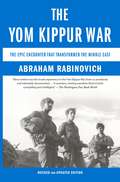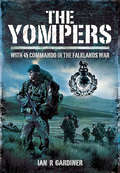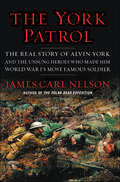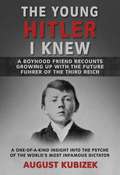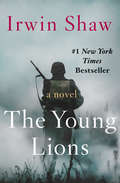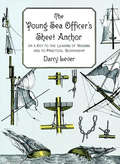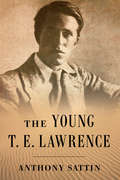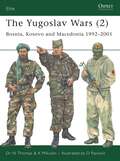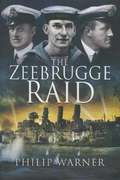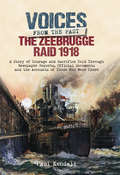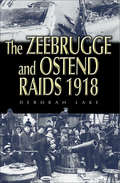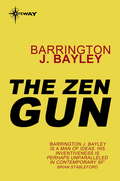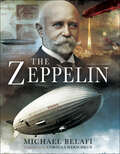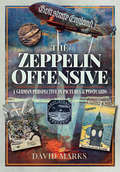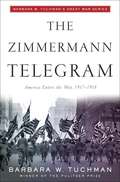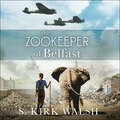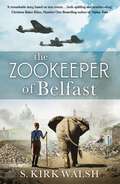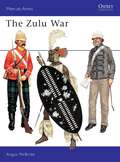- Table View
- List View
The Yom Kippur War: The Epic Encounter That Transformed the Middle East
by Abraham RabinovichA US journalist now living in Jerusalem who has written several books on Israel chronicles the 1973 war that dramatically altered the regional map and politics. Based on interviews with Israeli Army commanders and other sources, this account also discusses Arab perspectives and the war's legacy, and includes photos and maps. Annotation ©2004 Book News, Inc. , Portland, OR (booknews. com)
The Yompers: With 45 Commando in the Falklands War
by Ian GardinerCalled to action on 2 April 1982, the men of 45 Commando Royal Marines assembled from around the world to sail 8,000 miles to recover the Falkland Islands from Argentine invasion. Lacking helicopters and short of food, they yomped in appalling weather carrying overloaded rucksacks, across the roughest terrain. Yet for a month in mid-winter, they remained a cohesive fighting-fit body of men. They then fought and won the highly successful and fierce night battle for Two Sisters, a 1,000 foot high mountain which was the key to the defensive positions around Stanley.This is a first hand story of that epic feat, but it is much more than that. The first to be written by a company commander in the Falklands War, the book gives a compelling, vivid description of the yomp and infantry fighting, and it also offers penetrating insights into the realities of war at higher levels. It is a unique combination of descriptive writing about front-line fighting and wider reflections on the Falklands War, and conflict in general.Gritty and moving; sophisticated, reflective and funny, this book offers an abundance of timeless truths about war.Postscript: Yomping was the word used by the Commandos for carrying heavy loads on long marches. It caught the publics imagination during this short but bitter campaign and epitomized the grim determination and professionalism of our troops.
The York Patrol: The Real Story of Alvin York and the Unsung Heroes Who Made Him World War I's Most Famous Soldier
by James Carl Nelson"Exceptional military history worthy of its heroic subject." —Matthew J. DavenportIn the vein of Band of Brothers and American Sniper, a riveting history of Alvin York, the World War I legend who killed two dozen Germans and captured more than 100, detailing York's heroics yet also restoring the unsung heroes of his patrol to their rightful place in history—from renowned World War I historian James Carl Nelson.October 8, 1918 was a banner day for heroes of the American Expeditionary Force. Thirteen men performed heroic deeds that would earn them Medals of Honor. Of this group, one man emerged as the single greatest American hero of the Great War: Alvin Cullum York. A poor young farmer from Tennessee, Sergeant York was said to have single-handedly killed two dozen Germans and captured another 132 of the enemy plus thirty-five machine guns before noon on that fateful Day of Valor. York would become an American legend, celebrated in magazines, books, and a blockbuster biopic starring Gary Cooper. The film, Sergeant York, told of a hell-raiser from backwoods Tennessee who had a come-to-Jesus moment, then wrestled with his newfound Christian convictions to become one of the greatest heroes the U.S. Army had ever known. It was a great story—but not the whole story.In this absorbing history, James Carl Nelson unspools, for the first time, the complete story of Alvin York and the events that occurred in the Argonne Forest on that day. Nelson gives voice, in particular, to the sixteen “others” who fought beside York. Hailing from big cities and small towns across the U.S. as well as several foreign countries, these soldiers included a patrician Connecticut farmer whose lineage could be traced back to the American Revolution, a poor runaway from Massachusetts who joined the Army under a false name, and a Polish immigrant who enlisted in hopes of expediting his citizenship. The York Patrol shines a long overdue spotlight on these men and York, and pays homage to their bravery and sacrifice. Illustrated with 25 black-and-white images, The York Patrol is a rousing tale of courage, tragedy, and heroism.
The Young Hitler I Knew: A Boyhood Friend Recounts Growing Up with the Future Fuhrer of the Third Reich
by Mr. August KubizekAugust Kubizek met Adolf Hitler in 1904 while they competed for standing room at the opera. Kubizek describes a reticent young man, painfully shy, yet capable of bursting into hysterical fits of anger if anyone disagreed with him. But they grew close, often talking for hours on end. In 1908, they began sharing an apartment in Vienna. After being rejected twice from art school, Hitler found himself sinking into an unkind world of &“constant unappeasable hunger.&” Kubizek did not meet his friend again until he congratulated him on becoming Chancellor of Germany. The Young Hitler I Knew tells the story of an extraordinary friendship, and gives fascinating insight into Hitler&’s character during these formative years.
The Young Lions
by Irwin ShawStanding alongside Norman Mailer's The Naked and the Dead and James Jones's From Here to Eternity, The Young Lions is one of the most powerful American novels to tackle the Second World War. Ambitious in its scope and robust in its prose, Irwin Shaw's work is also deeply humanistic, presenting the reality of war as seen through the eyes of ordinary soldiers on both sides. The story follows the individual dramas — and ultimately intertwined destinies — of Christian Diestl, a Nazi sergeant; Noah Ackerman, a Jewish American infantryman; and Michael Whitacre, an idealistic urbanite from the New York theatrical world. Diestl first appears as a dashing ski instructor in Austria, mouthing his loyalty to Nazi ideals. As the war progresses, Diestl's character continues to erode as he descends into savagery. Ackerman must endure domestic anti-Semitism and beatings in boot camp before proving himself in the European theater. Eventually, as part of the liberating army, he comes face-to-face with the unimaginable horrors of the death camps. Whitacre, trading cocktail parties for Molotov cocktails, confronts the barbarism of war, and in fighting simply to survive, finds his own capacity for heroism. Shaw's sweeping narrative is at once vivid, exciting, and brutally realistic as well as poignant in its portrayal of the moral devastation and institutional insanity of war. Penned by a master storyteller at the height of his craft, The Young Lions stands the test of time as a classic novel of war and the human experience.
The Young Lions: A Novel
by Irwin ShawOne of the great World War II novels, this New York Times–bestselling &“masterpiece&” captures the experiences of three very different soldiers (The Boston Globe). Standing alongside Norman Mailer&’s The Naked and the Dead and James Jones&’s From Here to Eternity, The Young Lions is one of the most powerful American novels to tackle the Second World War. Ambitious in its scope and robust in its prose, Irwin Shaw&’s work is also deeply humanistic, presenting the reality of war as seen through the eyes of ordinary soldiers on both sides. The story follows the individual dramas—and ultimately intertwined destinies—of Christian Diestl, a Nazi sergeant; Noah Ackerman, a Jewish American infantryman; and Michael Whitacre, an idealistic urbanite from the New York theatrical world. Diestl first appears as a dashing ski instructor in Austria, mouthing his loyalty to Nazi ideals. As the war progresses, Diestl&’s character continues to erode as he descends into savagery. Ackerman must endure domestic anti-Semitism and beatings in boot camp before proving himself in the European theater. Eventually, as part of the liberating army, he comes face-to-face with the unimaginable horrors of the death camps. Whitacre, trading cocktail parties for Molotov cocktails, confronts the barbarism of war, and in fighting simply to survive, finds his own capacity for heroism. Shaw&’s sweeping narrative is at once vivid, exciting, and brutally realistic as well as poignant in its portrayal of the moral devastation and institutional insanity of war. Penned by a master storyteller at the height of his craft, The Young Lions stands the test of time as a classic novel of war and the human experience. This ebook features an illustrated biography of Irwin Shaw including rare images and never-before-seen documents from the author&’s estate.
The Young Lions: A Novel (Phoenix Fiction Ser.)
by Irwin ShawOne of the great World War II novels, this New York Times–bestselling &“masterpiece&” captures the experiences of three very different soldiers (The Boston Globe). Standing alongside Norman Mailer&’s The Naked and the Dead and James Jones&’s From Here to Eternity, The Young Lions is one of the most powerful American novels to tackle the Second World War. Ambitious in its scope and robust in its prose, Irwin Shaw&’s work is also deeply humanistic, presenting the reality of war as seen through the eyes of ordinary soldiers on both sides. The story follows the individual dramas—and ultimately intertwined destinies—of Christian Diestl, a Nazi sergeant; Noah Ackerman, a Jewish American infantryman; and Michael Whitacre, an idealistic urbanite from the New York theatrical world. Diestl first appears as a dashing ski instructor in Austria, mouthing his loyalty to Nazi ideals. As the war progresses, Diestl&’s character continues to erode as he descends into savagery. Ackerman must endure domestic anti-Semitism and beatings in boot camp before proving himself in the European theater. Eventually, as part of the liberating army, he comes face-to-face with the unimaginable horrors of the death camps. Whitacre, trading cocktail parties for Molotov cocktails, confronts the barbarism of war, and in fighting simply to survive, finds his own capacity for heroism. Shaw&’s sweeping narrative is at once vivid, exciting, and brutally realistic as well as poignant in its portrayal of the moral devastation and institutional insanity of war. Penned by a master storyteller at the height of his craft, The Young Lions stands the test of time as a classic novel of war and the human experience. This ebook features an illustrated biography of Irwin Shaw including rare images and never-before-seen documents from the author&’s estate.
The Young Sea Officer's Sheet Anchor: Or a Key to the Leading of Rigging and to Practical Seamanship
by Darcy LeverWidely used among young 19th-century officers in the Royal Navy and East India Company, this now-rare volume offers clear definitions and copious illustrations of the principles of rigging and other aspects of seamanship -- tacking, use of a compass, splicing ropes, making sails, and much more. A must for ship fanciers and naval historians.
The Young T. E. Lawrence
by Anthony SattinAn intimate biography of the years that turned T. E. Lawrence into Lawrence of Arabia. Lawrence of Arabia's heroism during the Arab revolt and his disgust at the subsequent betrayal of the Arabs in the postwar negotiations have become the stuff of legend. But T. E. Lawrence's adventures in the Levant began long before the outbreak of war. This intimate biography is the first to focus on Lawrence in his twenties, the untold story of the awkward archaeologist from Oxford who, on first visiting "The East," fell in love with Arab culture and found his life's mission. Few people realize that Lawrence's classic autobiography, Seven Pillars of Wisdom, was not the first book to carry that iconic title. Lawrence himself burned his original draft. Anthony Sattin here uncovers the story Lawrence wanted to conceal: the truth of his birth, his tortuous relationship with a dominant mother, his deep affection for an Arab boy, and the personal reasons that drove him from student to spy. Drawing on surviving letters, diaries, and accounts from close confidantes, Sattin brings a biographer's eye for detail and a travel writer's verve to Lawrence's extraordinary journeys through the region with which his name is forever connected. In a masterful parallel narrative, The Young T. E. Lawrence charts the maturation of the man and the incipient countries he treasured, both coming of age at a time when the world's foundations were coming undone.
The Yugoslav Wars
by Nigel Thomas Darko Pavlovic K. MikulanOsprey's examination of Bosnia, Kosovo and Macedonia's involvement in the Yugoslav Wars (1991-1995), as well as their involvement in the conflicts of the years that followed. Following the death of the Yugoslavian strongman President Tito in 1980, the several semi-autonomous republics and provinces that he had welded into a nation in 1945 moved inexorably towards separation. As the world watched a series of wars ripped through this modern European state. In this second of two volumes, experts on the Balkan region give an unprecedented, clear and concise explanation of the armies of the the Bosnian Civil War 1992-5 as well as the conflicts in Kosovo and Macedonia. This includes the regular and militia forces which fought in these campaigns and which ultimately resulted in the UN/NATO policing of the region that continues to this day. The book is illustrated with rare photos and an extraordinary range of colour uniform plates.
The Zealot: A Roman Legion Novel
by Simon ScarrowThe thrilling adventures of two Roman centurions continue as they’re called to stop a threat rising in the Empire’s eastern provinces.Trouble is brewing on the eastern frontier of the Roman Empire. The troops are in a deplorable state, while the corrupt behavior of their senior officers threatens to undermine the army’s control of the region. To restore competence of the men defending a vital fort, two experienced centurions are dispatched to Judea. On their arrival Cato and Macro discover that Bannus, a local tribesman, is fomenting rebellion among the followers of Jehoshua, who was crucified in Jerusalem some seventeen years earlier. As the local revolt grows, Rome’s longstanding enemy Parthia is poised to invade, Cato and Macro must stamp out corruption in the cohort before the Eastern provinces are lost forever . . . Simon Scarrow’s Roman Legion series chronicling the adventures of centurions Cato and Macro has been met with near universal acclaim, drawing comparisons to the best of his contemporaries including Bernard Cornwell, Conn Iggulden, and Harry Sidebottom. A master of his craft, Simon Scarrow combines stunning historical detail with riveting battles and rich characters to bring the Roman Empire to life as never before.Originally published in the UK as The Eagle in the SandPraise for Simon Scarrow’s Roman Legion series“I really don’t need this kind of competition.” —Bernard Cornwell“Scarrow manages to summon up all the glory and the gore that characterized life in the Roman legions. Outstanding . . . a new master of the genre.” —Booklist“A combustible concoction of intrigue, treachery, and violence. . . . Scarrow’s combat is brutal and sanguinary; his imperial politics are almost as sharp.” —Publishers Weekly“Scarrow again provides a vivid sense of history and believable scenes of maritime action. His righteous but flawed protagonists are winning heroes.” —Kirkus Reviews“All the hallmarks of Bernard Cornwell at his best.” —Oxford Times
The Zeebrugge Raid
by Philip WarnerOn 23 April 1918 a force drawn from the Royal Navy and Royal Marines launched one of the most daring raids in history. The aim was to block the Zeebrugge Canal, thereby denying U-boat access, although this meant assaulting a powerfully fortified German naval base. The raid has long been recognised for its audacity and ingenuity but, owing to the fact that the official history took overmuch notice of the German version of events, has been considered only a partial success. The error of that view is now exposed, for in this stirring account there is evidence from many sources that the raid achieved much more than is usually credited to it. The raid is presented from a variety of viewpoints, from the airmen who took part in the preliminary bombing to the motor launches which picked up survivors. The crews of the launches and coastal motor boats were frequently 'amateur' sailors but their courage and skill were second to none. Philip Warner has talked with many of the survivors and corresponded with others, some of whom now live in distant parts of the world.
The Zeebrugge Raid 1918: A Story of Courage and Sacrifice Told Through Newspaper Reports, Official Documents and the Accounts of Those Who Were There (Voices from the Past)
by Paul KendallApproximately a third of all Allied merchant vessels sunk during the First World War were by German boats and submarines based at Bruge-Zeebrugge on the coast of Belgium. By 1918 it was feared that Britain would be starved into surrender unless the enemy raiders could be stopped. A daring plan was therefore devised to sail directly into the heavily defended port of Zeebrugge and then to sink three obsolete cruisers in the harbour in the hope they would block German vessels from reaching the English Channel. The cruisers were also to be accompanied by two old submarines, which were filled with explosives to blow up the viaduct connecting the mole to the shore, whilst 200 Marines were to be landed to destroy German gun positions at the entrance to the Bruges Canal.On 23 April the most ambitious amphibious raid of the First World War was carried out, told here through a huge collection of personal accounts and official reports on the bitter fighting which saw more than 500 British casualties from the 1,700 men who took part, and saw the awarding of eight Victoria Crosses.
The Zeebrugge and Ostend Raids 1918 (Battleground Channel Ports Ww1 Ser.)
by Deborah LakeThe unrestricted U-Boat war threatened the very survival of Britain, whose reliance on imported food and war materials was her Achilles Heel. A significant element of the German submarine fleet operated from the occupied Belgian ports of Zeebrugge and Ostend. After careful planning the Royal Navy launched audacious attacks on these two ports on St Georges Day 1918. Five obsolete cruisers and two Mersey ferries supported by a flotilla of smaller vessels penetrated the near impregnable defenses, while Royal Marines and naval storming parties battle ashore in a diversionary attack. At the time of the action the concrete filled block ships were scuttled in the ports approaches.Despite being a costly and bloody affair for the participants, the survivors returned to acclaim. The raids gave a fillip to the national morale, at a time of depressing news from the Front. To underline the success of the affair no less than 11 Victoria Crosses were awarded.
The Zen Gun
by Barrington J. BayleyPout, the chimera, half-man, half-ape, was incorporated into one of the plants or vice versa. He was jammed into a squatting position, while the stems, entering at his buttocks, merged with his legs, his arms and his torso, emerging at knees, elbows, and through his abdomen and thorax. A large, yellow-petalled flower seemed to frame his face.It was his face that rivetted Ikematsu's attention, while the chimera squirmed in dumb distress, glaring with huge piteous eyes. For in that face, set into it as if set in pudding, was the zen gun. The gun was his face, or a part of it. The barrel pointed straight out in place of a nose... the stock merged with and disappeared into Pout's pendulous mouth. Ikematsu leaned toward the chimera. "How you loved your toy! Now it is truly yours!"
The Zeppelin
by Michael BelafiThis new publication from Michael Belafi offers some truly intriguing content. Photographs of the mighty Zeppelin at all stages of development feature in a publication that aims to chart the entire course of the airship's history. Named after the German Count Ferdinand Von Zeppelin, an early pioneer of rigid airship development, the Zeppelin was first flown commercially by Deutsch Luftschiffahrts (DELAG), the world's first airline in revenue service. By mid–1914, DELAG had carried over 10,000 fare-paying passengers on over 1500 flights. When war hit, it was employed to military advantage, wreaking carnage upon Britain's towns and cities. German defeat in 1918 temporarily halted the airship business (many had to be surrendered under the terms of the Treaty of Versailles), although it did bounce back with the construction of the Graf Zeppelin in the 30s. A series of terrible accidents was soon to signal the demise of the Zeppelin however; following the Hindenburg disaster of 1937, and in the midst of a host of political and economic issues, the Zeppelin was soon to be consigned to the history books as one of the great aviation relics of the 20th Century. This new publication explores each facet of its history, and concludes by assessing the legacy of rigid airship development, still felt to this day.
The Zeppelin Offensive: A German Perspective in Pictures and Postcards
by David MarksAirship propaganda that&’s &“a visual treat . . . it will appeal to all those interested in how artwork was harnessed to convey information in time of war&” (Firetrench). Books on the Zeppelin raids during the First World War have, traditionally, focused on the direct impact of Britain, from the devastating effects on undefended towns and cities, the psychological impact of this first weapon of total war to the technological and strategic advances that eventually defeated the &“Baby Killers.&” Now, drawing on the largest postcard collection of its kind and other period memorabilia, David Marks tells the story of the Zeppelin during the First World War from a viewpoint that has rarely been considered: Germany itself. From its maiden flight in July 1900, the Zeppelin evolved into a symbol of technology and national pride that, once war was declared, was at the forefront of German&’s propaganda campaign. The Zeppelin links the rampant xenophobia at the outbreak of the conflict against England (it almost never was called Britain), France, Russia and their allies to the political doctrines of the day. The postcards that profusely illustrate this book show the wide-ranging types of propaganda from strident Teutonic imagery, myths and legends, biting satire and a surprising amount of humor. This book is a unique contribution to our understanding of the place of the Zeppelin in Germany&’s culture and society during the First World War. &“Well-recommended for its unique visual and psychological insights.&” —Over the Front &“Perfectly conveys the early optimism of the Zeppelin as both a symbol of national prestige and the weapon which would win the War.&” —Donna&’s Book Blog
The Zimmermann Telegram
by Barbara W. TuchmanIn January 1917 when World War I was deadlocked, the British intercepted a telegram from Berlin, which they knew would bring America to the aid of the Allies. This is the story of how the message was decoded and how it was put to use by the British.
The Zimmermann Telegram
by Thomas BoghardtBy the winter of 1916/17, World War I had reached a deadlock. While the Allies commanded greater resources and fielded more soldiers than the Central Powers, German armies had penetrated deep into Russia and France, and tenaciously held on to their conquered empire. Hoping to break the stalemate on the western front, the exhausted Allies sought to bring the neutral United States into the conflict.A golden opportunity to force American intervention seemed at hand when British naval intelligence intercepted a secret telegram detailing a German alliance offer to Mexico. In it, Berlin's foreign secretary, Arthur Zimmermann, offered his country's support to Mexico for re-conquering "the lost territory in Texas, New Mexico, and Arizona" in exchange for a Mexican attack on the United States, should the latter enter the war on the side of the Allies. The British handed a copy of the Telegram to the American government, which in turn leaked it to the press. On March 1, 1917, the Telegram made headline news across the United States, and five weeks later, America entered World War I.Based on an examination of virtually all available German, British, and U.S. government records, this book presents the definitive account of the Telegram and questions many traditional views on the origins, cryptanalysis, and impact of the German alliance scheme. While the Telegram has often been described as the final step in a carefully planned German strategy to gain a foothold in the western hemisphere, this book argues that the scheme was a spontaneous initiative by a minor German foreign office official, which gained traction only because of a lack of supervision and coordination at the top echelon of the German government. On the other hand, the book argues, American and British secret services had collaborated closely since 1915 to bring the United States into the war, and the Telegram's interception and disclosure represented the crowning achievement of this clandestine Anglo-American intelligence alliance. Moreover, the book explicitly challenges the widely accepted notion that the Telegram's publication in the U.S. press rallied Americans for war. Instead, it contends that the Telegram divided the public by poisoning the debate over intervention, and by failing to offer peace-minded Americans a convincing rationale for supporting the war. The book also examines the Telegram's effect on the memory of World War I through the twentieth century and beyond.
The Zookeeper of Belfast: A heart-stopping WW2 historical novel based on an incredible true story
by S. Kirk WalshA stunning World War Two novel for fans of Natasha Lester, Heather Morris, Kate Furnivall, Mandy Robotham, based on a true story.As the bombs rain down on the city, Belfast's first ever female zookeeper must fight to save the baby elephant in her charge in this gripping, uplifting tale based on a true story.1941. With the men away fighting, animal-lover Hettie Quin is made Belfast Zoo's first ever female zookeeper. She is put in charge of Violet, a three-year-old Indian elephant, and they soon form a special bond. With Violet at her side, Hettie can almost escape the grim reality of her life: the father who has abandoned her family; the sister who recently died; the war that's raging hundreds of miles away.But the devastation of war is closer than she thought. When the bombs begin to rain down on the city, Hettie must gather all her courage to protect those she loves the most. Can she save Violet - and get through unscathed herself?Based on a true story, The Zookeeper of Belfast is a gripping and uplifting tribute to what one woman's courage and tenacity can achieve in the most dire of circumstances - perfect for fans of Heather Morris, Natasha Lester, Kate Furnivall, Mandy Robotham and Fiona Valpy.Praise for THE ZOOKEEPER OF BELFAST:'Walsh delivers a turbulent portrait of life in a divided city . . . A unique perspective of a country at war and the lengths people will go for those they love.' - Kirkus Reviews'Sensitively rendered and finely drawn, this remarkable story, based on true events, is both uplifting and heartbreaking.' - Christina Baker Kline, #1 New York Times bestselling author of Orphan Train'Walsh has written a novel of deep affection and knife-edge suspense. A brilliant debut.' - Margot Livesey, author of The Boy in The Field'An elephant, a young zookeeper, the city of Belfast, bombings, and an IRA member are the improbable characters in this captivating and intimately felt novel that tells the story of a young woman's uncommon devotion and courage under fire.' - Lily Tuck, author of Sisters'A zoo in wartime Belfast and a young woman's fierce love for the elephant in her care come vividly to life in this beautiful, beguiling, and atmospheric debut novel.' - Dominic Smith, author of The Last Painting of Sara de Vos·Cinematic in scope and brimming with emotion, this is a soaring work of historical imagination.' - Karen Olsson, author of All the Houses(P) 2021 Hodder & Stoughton Ltd
The Zookeeper of Belfast: A heart-stopping WW2 historical novel based on an incredible true story
by S. Kirk WalshAs the bombs rain down on the city, Belfast's first ever female zookeeper must fight to save the baby elephant in her charge in this gripping, uplifting tale based on a true story.1941. With the men away fighting, animal-lover Hettie Quin is made Belfast Zoo's first ever female zookeeper. She is put in charge of Violet, a three-year-old Indian elephant, and they soon form a special bond. With Violet at her side, Hettie can almost escape the grim reality of her life: the father who has abandoned her family; the sister who recently died; the war that's raging hundreds of miles away.But the devastation of war is closer than she thought. When the bombs begin to rain down on the city, Hettie must gather all her courage to protect those she loves the most. Can she save Violet - and get through unscathed herself?Based on a true story, The Zookeeper of Belfast is a gripping and uplifting tribute to what one woman's courage and tenacity can achieve in the most dire of circumstances - perfect for fans of Heather Morris, Natasha Lester, Kate Furnivall, Mandy Robotham and Fiona Valpy.Praise for THE ZOOKEEPER OF BELFAST:'Walsh delivers a turbulent portrait of life in a divided city . . . A unique perspective of a country at war and the lengths people will go for those they love.' - Kirkus Reviews'Sensitively rendered and finely drawn, this remarkable story, based on true events, is both uplifting and heartbreaking.' - Christina Baker Kline, #1 New York Times bestselling author of Orphan Train'Walsh has written a novel of deep affection and knife-edge suspense. A brilliant debut.' - Margot Livesey, author of The Boy in The Field'An elephant, a young zookeeper, the city of Belfast, bombings, and an IRA member are the improbable characters in this captivating and intimately felt novel that tells the story of a young woman's uncommon devotion and courage under fire.' - Lily Tuck, author of Sisters'A zoo in wartime Belfast and a young woman's fierce love for the elephant in her care come vividly to life in this beautiful, beguiling, and atmospheric debut novel.' - Dominic Smith, author of The Last Painting of Sara de Vos·Cinematic in scope and brimming with emotion, this is a soaring work of historical imagination.' - Karen Olsson, author of All the Houses
The Zookeeper's Wife: A War Story (Movie Tie-in Editions #0)
by Diane AckermanThe New York Times bestseller now a major motion picture starring Jessica Chastain. 1939: the Germans have invaded Poland. The keepers of the Warsaw zoo, Jan and Antonina Zabinski, survive the bombardment of the city, only to see the occupiers ruthlessly kill many of their animals. The Nazis then carry off the prized specimens to Berlin for their program to create the “purest” breeds, much as they saw themselves as the purest human race. Opposed to all the Nazis represented, the Zabinskis risked their lives by hiding Jews in the now-empty animal cages, saving as many as three hundred people from extermination. Acclaimed, best-selling author Diane Ackerman, fascinated both by the Zabinskis’ courage and by Antonina’s incredible sensitivity to all living beings, tells a moving and dramatic story of the power of empathy and the strength of love. A Focus Features release, it is directed by Niki Caro, written by Angela Workman.
The Zookeeper's Wife: A War Story (Thorndike Biography Ser. #0)
by Diane Ackerman<P>The New York Times bestseller: a true story in which the keepers of the Warsaw Zoo saved hundreds of people from Nazi hands. After their zoo was bombed, Polish zookeepers Jan and Antonina Zabinski managed to save over three hundred people from the Nazis by hiding refugees in the empty animal cages. With animal names for these "guests," and human names for the animals, it's no wonder that the zoo's code name became "The House Under a Crazy Star." <P>Best-selling naturalist and acclaimed storyteller Diane Ackerman combines extensive research and an exuberant writing style to re-create this fascinating, true-life story--sharing Antonina's life as "the zookeeper's wife," while examining the disturbing obsessions at the core of Nazism. <P><b>Winner of the 2008 Orion Award.</b> <P><b>A New York Times Bestseller</b>
The Zookeeper's Wife: An unforgettable true story, now a major film (Movie Tie-in Editions Ser. #0)
by Diane AckermanIn war-torn Warsaw, a zookeeper and his wife refuse to surrender... Now a major motion picture starring Jessica Chastain and Daniel Brühl, Diane Ackerman's The Zookeeper's Wife is based on a remarkable true story of bravery and sanctuary during World War II. Perfect for fans of Lion and Hidden Figures. 'I can't imagine a better story or storyteller. The Zookeeper's Wife will touch every nerve you have' -Jonathan Safran Foer, author of Everything is Illuminated When Germany invades Poland, Luftwaffe bombers devastate Warsaw and the city's zoo along with it. With most of their animals killed, or stolen away to Berlin, zookeepers Jan and Antonina Zabinski begin smuggling Jews into the empty cages.As the war escalates Jan becomes increasingly involved in the anti-Nazi resistance. Ammunition is buried in the elephant enclosure and explosives stored in the animal hospital. Plans are prepared for what will become the Warsaw uprising. Through the ever-present fear of discovery, Antonina must keep her unusual household afloat, caring for both its human and animal inhabitants - otters, a badger, hyena pups, lynxes - as Europe crumbles around them.Written with the narrative drive and emotional punch of a novel, The Zookeeper's Wife is a remarkable true story. It shows us the human and personal impact of war - of life in the Warsaw Ghetto, of fighting in the anti-Nazi resistance. But more than anything it is a story of decency and sacrifice triumphing over terror and oppression. What readers are saying about The Zookeeper's Wife: 'Beautifully and sensitively written - a must read''An adventure that inspires''Both horrifying and endearing on a scale I've not experienced in years''A story that will haunt you forever''Haunting, life affirming, sad, and inspiring'
The Zulu War
by Angus McbrideBy the end of the nineteenth century the fame of the Zulu was world-wide, and their army was one of the few non-European military organizations to have become the subject of serious historical study. Their very name is still synonymous with bravery, discipline and military skill. This excellent addition to Osprey's Men-at-Arms series tells the story of the Zulus at war, from their rise to unrivalled power under the fearsome Shaka to the final devastating defeat against the British at Ulundi, detailing Zulu weapons and tactics, and the famous battles in which they fought.
